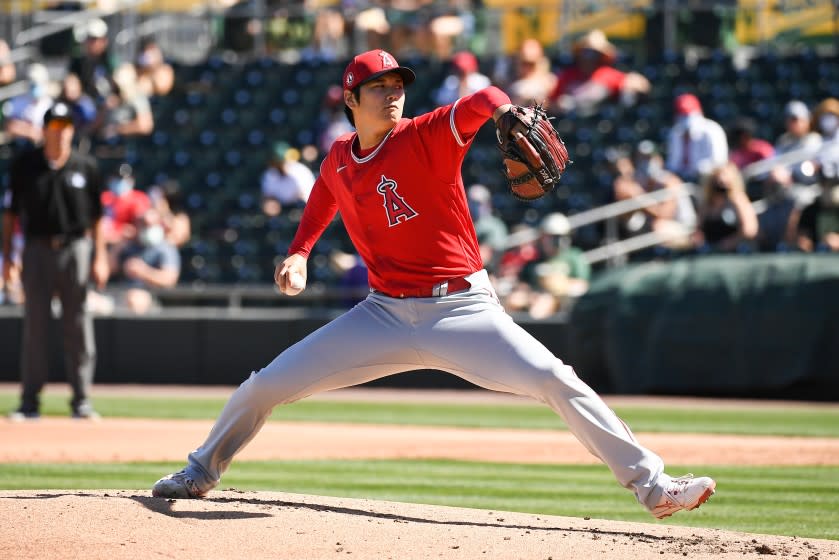Hernández: Shohei Ohtani may finally be two-way star the Angels envisioned

How quickly the story has changed, the fears about what could go wrong for Shohei Ohtani replaced by anticipation of the exospheric heights he could reach. What started as a make-or-break spring has morphed into a season of renewed possibilities.
Two days after walloping a 468-foot home run over the batter’s eye at Tempe Diablo Stadium, Ohtani touched 100 mph with his fastball and struck out five Oakland Athletics over 1 2/3 innings Friday in the Angels' 7-3 spring training win in seven innings at Hohokam Stadium in Mesa, Ariz.
Suddenly, the 26-year-old Ohtani resembles the two-way player who dominated Japanese baseball and was the subject of hyperbolic scouting reports.
He looks like Superman.
His early camp form has temporarily subsided the mounting industry-wide speculation that he could soon be forced to abandon pitching and become a full-time hitter.
By the start of the regular season, he should be a fashionable dark-horse MVP pick.
“I think he's having lot of fun,” Angels manager Joe Maddon said. “I don't see the same stress I saw in his face last year.”
The simplest explanation is that Ohtani is finally healthy. Last year, he was recovering from a knee operation. The previous year, reconstructive elbow surgery. Three years ago, an ankle procedure.
“Last year and the year before that, my routine included rehabilitation,” Ohtani said in Japanese. “Maybe I didn't have as much fun.”
The left-handed-hitting Ohtani has particularly enjoyed batting, as the surgically repaired knee on his back leg feels sturdier.
“I don't have to think too much and can just do in the game what I've worked on in practice,” he said.
Ohtani has always taken a more serious approach to his pitching, which he done little of since signing with the Angels. An injury to his throwing elbow limited him to 10 starts in his rookie season in 2018 and required a major operation after the season. He returned to the mound last year, but his comeback lasted only two starts, as his right elbow flared up again.
Which made how he performed Friday particularly encouraging.
“It was my first game, so I thought I should try to throw nice and easy,” Ohtani said.

Nice and easy for Ohtani translated to fastballs in the 96-100 mph range. He gave up a double and a walk in the first inning but struck out the side.
He was charged with two doubles, a walk and a run in the second inning, but the two outs he recorded were on strikeouts. He was removed from the game with two outs, two on and his pitch count at 41.
He registered his first two strikeouts with fastballs, the next three with splitters. While he encountered trouble spinning his slider early in counts and his fastball at times late, he said his arm “for sure” felt better than it did last year.
Maddon noted there were times Ohtani was flipping the ball to himself between pitches.
“Guys only do that when they’re pretty much in a moment calm and things aren’t spinning too quickly,” Maddon said.
More than the radar gun readings, Maddon was pleased with Ohtani’s delivery, which looked more compact than in the past.
Ohtani has also made mechanical changes in the batter’s box, as he’s moved his front elbow up closer to his chin. The more upright stance helps him maintain his balance and see the ball better. The improved strength of his left knee allows him to stay back on pitches longer. Able to weight train over the winter without any restrictions, he’s added noticeable mass to his 6-foot-4 frame.
The pitch he blasted over the batter’s eye Wednesday was the kind of pitch that troubled him in the past — a high fastball.
“There was wind, so who knows what to make of the distance,” Ohtani said without irony. “But it went up at a good angle, which means I'm attacking the ball with a good motion.”
There will be other adjustments. When he has pitched in previous years, Ohtani has pitched once a week, usually on Sundays. His typical seven-day cycle consisted of him playing as a designated hitter Tuesday through Friday, resting Saturday, pitching Sunday, and resting again Monday. He’s had this schedule since he played for the Nippon-Ham Fighters in the Japanese league.
The sequence figures to be shortened by a day, as Maddon said Ohtani will be treated like everyone else in the team’s six-man rotation.
“Whenever his day comes up, his day comes up,” Maddon said.
How often Ohtani plays will depend on how he feels, with Maddon counting on him to be honest with the coaches and trainers.
“The big thing was to put him in charge of his own career and not try to dictate so much to him, permit his athleticism to take over and not constantly be concerned about getting hurt,” Maddon said.
Maddon could have a point. It’s not as if the old way kept Ohtani on the field. He’s made it through an entire season as a two-way player only once, in 2016 with Nippon-Ham.
That was Ohtani’s best season in professional baseball. He was named to the Pacific League’s Best Nine both as a pitcher and designated hitter. He captured the league’s MVP award and Nippon-Ham won the Japan Series.
Replicating that in the major leagues could be a stretch. At this moment of spring training, however, everything feels like it’s within his oversized reach.
This story originally appeared in Los Angeles Times.

 Yahoo Sports
Yahoo Sports 